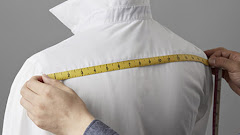An Interview with Emma Willis
by Lucy French
Tailoring in the Western world has a rich history, dating back to the early Middle Ages and possibly even earlier. Archaeological findings have unearthed evidence of tailors in Greek Antiquity, and recent discoveries of punctured bones dating back 40,000 years have been posited as tools used by prehistoric tailors. Today, a tailor is generally considered someone who can either make or alter garments to someone’s specific measurements.
The tradition persists prominently, with numerous tailoring houses around the UK. However, its epicentre is considered to be the iconic London streets, Savile Row and Jermyn Street. I had the pleasure of speaking with Jermyn Street shirtmaker Emma Willis, whose previous clients include actor Benedict Cumberbatch and HM King Charles III (then Prince of Wales). Her designs have also been featured in magazines like The Rake, British GQ, and Vogue, worn by celebrities such as Daniel Craig, Angelina Jolie, Tom Hanks, Samuel L. Jackson, and Pedro Pascal.
Fascinated by the history of the tailoring industry, I was compelled to ask: In a world increasingly focused on environmental impact and alternatives to fast fashion, is it worth looking back at our more traditional manufacturing practices?
Tailored clothing is typically categorized into three groups: Bespoke, Made-to-Measure, and Ready-to-Wear. Made-to-Measure involves adjusting a pre-existing shirt pattern, described by Willis as a "jigsaw puzzle", for a personalised fit. In contrast, a Bespoke pattern is drawn up on paper, using around 16 measurements, each part of the garment created for the individual's body shape and stored for future orders.Willis highlighted the sustainability of Bespoke and Made-to-Measure clothing, emphasizing the benefits of in-house manufacturing. Namely, it reduces wastage and ensures more efficient use of fabric, Willis explains: “We do supply and demand and […] we don’t sit on huge amount of stock”. Repair options, such as replacing collars or cuffs, also increase garment longevity, while customer experience and enjoyment fosters continued wear. Willis mentioned, "a man sent me a message last week, saying of his new bespoke, that it made him feel comfortable with himself." These garments are intended to be worn until they naturally wear out, aligning with a sustainable fashion approach.
I was also interested in the brand’s specific sustainable practices. I observed that as a smaller brand, Willis was able to have more control over the business’s sustainable objectives. Willis explained the brand’s upcycling initiative, spare shirt fabric is used to make cotton boxers and even button bags for customers. “We don’t have much fabric left over. We’re always looking for new ways of using our remnants” she explained. The business’s plastic consumption is likewise kept to a minimum, with all the plastic packaging being entirely recycled and recyclable.
More than this, Willis highlighted the advantage of having a UK based factory for reducing air miles and transportation, which customers often cite as being an appealing aspect of the brand. While raw cotton unfortunately has to be grown in countries like America and Egypt, Willis’s factory is situated just two hours from London, while all the fabric is finished in Europe (a chemical and machinal process of preparing the fabric). Willis likewise highlighted her customers’ increased uptake of linen fabrics: “we do about 50 percent of our sales in linen, the most sustainable fabric on the planet”. She cited increased popularity of more informal clothing for this phenomenon.
More interestingly, Willis suggested that people might take on the challenge themselves, “I would love to think that the fashion to make clothes for yourself is on the return. Sales of sewing machines have increased dramatically in the last few years, even before the pandemic, maybe thanks to Sewing Bee, which could be an indication.”
Additionally, Willis emphasises the profound impact of recent global events on supply lines and production in the fashion industry. Brexit and the pandemic prompted a significant shift, with many companies relocating production closer to home, while very worrying recent challenges to global shipping could also incentivise more localised production and purchasing.
While bespoke clothing may currently be beyond the reach of some people due to its higher cost, it is heartening to witness a positive trajectory in the fashion industry. Despite challenges, the potential for bespoke clothing to become more mainstream is evident. As consumers increasingly prioritise sustainability and individuality, the prospect of smaller businesses offering bespoke and specially made clothes at a more accessible scale could become more of a reality. This shift not only aligns with current global issues, such as challenges in global shipping, but also reflects a broader movement toward conscious consumption. Bespoke clothing may well become a more inclusive and widespread choice for fashion enthusiasts, marking a positive future for the industry.




Comments
Post a Comment